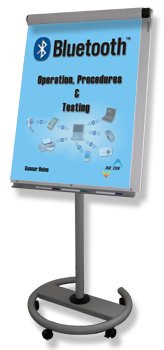 Bluetooth - Operation, Procedures & Testing
Bluetooth - Operation, Procedures & Testing
[2-day course, Euro 2,350.- (net) per participant]
 Around the Bluetooth Specification
Around the Bluetooth Specification

- Administratives
Introduction to Bluetooth, The ISM-Frequency Band and International Availability of Frequencies, The Special Interest Group (SIG) - Business Aspects of Bluetooth
Targeted Applications, History & Future, Bluetooth 2.0, Market Analysis - The Bluetooth Qualification Program
Functions of BQA, BQRB, BQB and BQTF, Interoperability Testing among Vendors, Important Links - Bluetooth vs. Alternative Technologies
Bluetooth vs. 802.11, Bluetooth vs. IrDA, Bluetooth vs. Home RF
 Comprehensive Introduction to Bluetooth Technology and Operation
Comprehensive Introduction to Bluetooth Technology and Operation
- Bluetooth Networking
Ad Hoc Networking, Master <-> Slave Concept, Piconets and Scatternets - Introducing the Bluetooth Protocol Stack
From the Physical Layer to the Application, Tasks and Functions of the Different Layers, The Protocol Stack with and without the Host Controller Interface, The Concept of Profiles in the Bluetooth Specifications - Overview of Bluetooth Operation
Finding other Devices, Device Pairing, Service Discovery, Bluetooth Addressing, Asymmetric and Symmetric Performance
 Baseband Processing in Bluetooth
Baseband Processing in Bluetooth
- Physical Characteristics of Bluetooth
Modulation, Description of the Physical Channel, TDD- and TDM-Scheme, Slow Frequency Hopping in Bluetooth, Power Levels, Timing and Clocking (e.g. CLKN and CLKE) - Physical Links
SCO (Synchronous Connection Oriented) and ACL (Asynchronous Connection-Less), The Bluetooth Packet Structure (Access Code, Header, Payload), Packet Types - Logical Channels
LC-Channel (Link Control), LM-Channel (Link Manager), UA-Channel (User Asynchronous), UI-Channel (User Isochronous), US-Channel (User Synchronous) - The Data Processing Chain
Voice Encoding, Encryption, Whitening and Channel Coding - The Generation of Hopping Sequences
Paging & Inquiries, Page Response & Inquiry Response, Page Scan & Inquiry Scan, during a Connection
 Higher Layers of the Bluetooth Protocol Stack
Higher Layers of the Bluetooth Protocol Stack
- LC and LM (Link Controller and Link Manager)
Control Functions of the LC, Network Establishment, Link Configuration, Control of Low-Power Modes (Hold, Sniff, Park), Audio Codecs for Bluetooth, Authentication Functions, Encryption in Bluetooth (SAFER+), The Bluetooth Test Mode and Tests - HCI (Host Controller Interface)
Tasks and Functions of the HCI, HCI-Commands and Packets, HCI over USB, HCI over UART, HCI over RS 232, Flow Control - L2CAP (Logical Link Control And Adaptation Protocol)
Multiplexing Support in L2CAP, Segmentation and De-Segmentation, QoS-Support, L2CAP-Signaling Format and Message Exchange - SDP (Service Discovery Protocol)
Tasks and Functions, Data Representation, PDU-Format, Service Records and Service Attributes
 Interfacing to the Application Layer
Interfacing to the Application Layer
- RFCOMM (RS-232 Cable Emulation)
Specifics of Serial Ports and Serial Port Emulation, Frame Types and Structure in RFCOMM, Connection Establishment and Release, RFCOMM-Link Control through Multiplexor Frames - OBEX (Object Exchange)
Similarity with IrDA, Object Model, OBEX-Packet Structure, OBEX-Operations, OBEX Session Management. - TCS (Telephone Control part Specification)
Tasks and Functions, Signaling Format (Q.931), Call Establishment Signaling
 The Bluetooth Profiles
The Bluetooth Profiles
- Overview of the Bluetooth Profiles
Tasks and Functions of the different Profiles - Detailed Consideration of GAP (Generic Access Profile)
Feature and Parameter Definitions - Detailed Consideration of the Serial Port Profile
Feature and Parameter Definitions - Detailed Consideration of the Headset Profile
Feature and Parameter Definitions
v2.1
ℹ️ Try out the updated search below!
Search:
More Info:
General Information about this course
Schedule of this training course
Extract of this training course
Buy this book
INACON eBooks
Please have a look at our full offer

